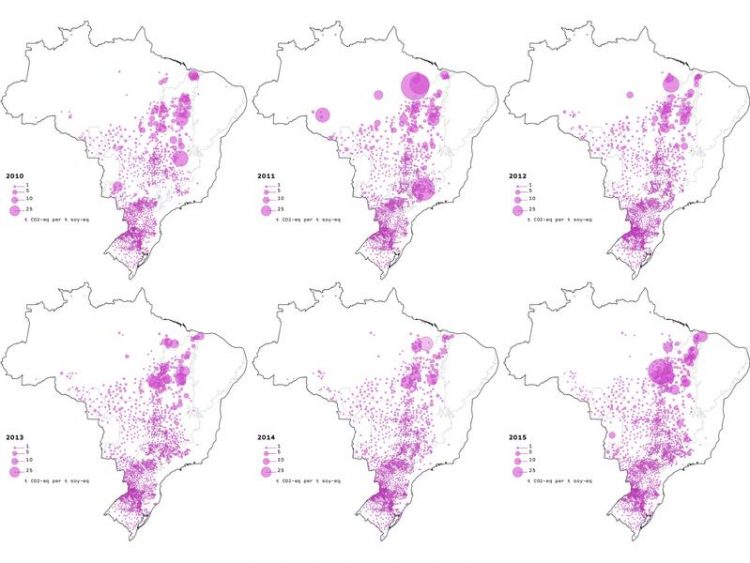Global trade in soy has major implications for the climate

The quantity of greenhouse gases released through the production, processing and export of soybean and derivatives varies greatly from municipality to municipality and from year to year. © Neus Escobar et. al., Global Environmental Change; DOI: 10.1016/j.gloenvcha.2020.102067
Global soy trade is a major source of greenhouse gas emissions for multiple reasons. The conversion of natural vegetation into arable land is probably the most important cause, since the latter generally binds considerably less CO2 than the original ecosystems. Greenhouse gases are also released during the harvesting of soybeans and processing into derived products, the subsequent transport to ports of export and shipment.
To estimate the carbon footprint embodied in Brazil's soy exports, researchers used the Life Cycle Assessment (LCA) methodology. This allows quantifying the environmental footprint of a product, from its production until it is delivered to the importer.
The researchers from the Institute for Food and Resource Economics (ILR) of the University of Bonn have performed this analysis for almost 90,000 supply chains that were identified in total soy exports from Brazil in the period 2010-2015.
“Each of these 90,000 individual trade flows represents a specific combination of the producing municipality in Brazil, the location in which the soy was stored and pre-processed, the respective export and import ports, and, where applicable, the country where further processing takes place,” explains the ILR researcher Dr Neus Escobar. “Put more simply, we have calculated the quantity of carbon dioxide released per tonne of soy exported through each of these supply chains.”
Around 90,000 soy trade flows analysed
For this purpose, the researchers used a database developed at the Stockholm Environment Institute (www.trase.earth). It traces the trade routes of agricultural commodity exports from the production region to the importer in detail.
“The database also contains spatially-explicit information on the deforestation associated with the soy cultivation in the production region,” says Escobar. “We supplemented it with additional data, for instance, on means of transport involved in the corresponding export route, as well as their CO2 emission intensity. This enabled us to make a very detailed assessment of the impact of soy cultivation in Brazil and subsequent transport on global greenhouse gas emissions.”
Interestingly, results show that: “The resulting greenhouse gas emissions vary considerably from municipality to municipality, depending on underlying deforestation, cultivation practices and freight logistics,” emphasizes Escobar. “The carbon footprint of some municipalities is more than 200 times larger than others. The variability is therefore much higher than so far reported in scientific literature.”
The greatest CO2 emissions arise from the so-called MATOPIBA region in the northeast of the country. This region still has large areas covered with natural vegetation, particularly forests and savannahs, which have however been increasingly lost to agriculture in recent years.
Furthermore, soy exports from municipalities in this region usually entail long transport distances to the ports of export, which are mostly covered by trucks due to the relatively poor infrastructure. Thus, greenhouse gas emissions from transport can be substantial and even surpass the effects of deforestation.
The researchers also investigated which countries generate particularly large quantities of greenhouse gas emissions by importing soy. First and foremost, the world’s largest importer is China, however, the European Union does not fall far behind. “Although European countries imported considerably smaller amounts of soy, between 2010 and 2015, this came primarily from areas where sizeable deforestation took place,” notes Escobar.
“Regional factors can have a significant influence on the environmental impacts embodied in global agricultural trade,” explains the researcher. “Our study helps to shed light on such relationships.” Policymakers urgently need such information: It can help to design low-carbon supply chains, for instance with improvements in the transport infrastructure or more effective forest conservation policies. Furthermore, it can also inform consumers about the environmental implications of high meat consumption, such as in many EU countries: A large proportion of the soy imported by Europe is used as animal feed.
Dr. Neus Escobar
Institute for Food and Resource Economics (ILR)
University of Bonn
Tel. +49-(0)228-733776
E-mail: neus.escobar@ilr.uni-bonn.de
Neus Escobar, E. Jorge Tizado, Erasmus K. H. J. zu Ermgassen, Pernilla Löfgren, Jan Börner and Javier Godar: Spatially-explicit footprints of agricultural commodities: mapping carbon emissions embodied in Brazil's soy exports; Global Environmental Change; DOI: 10.1016/j.gloenvcha.2020.102067
Media Contact
More Information:
http://www.uni-bonn.de/All latest news from the category: Agricultural and Forestry Science
Newest articles

Targeted use of enfortumab vedotin for the treatment of advanced urothelial carcinoma
New study identifies NECTIN4 amplification as a promising biomarker – Under the leadership of PD Dr. Niklas Klümper, Assistant Physician at the Department of Urology at the University Hospital Bonn…

A novel universal light-based technique
…to control valley polarization in bulk materials. An international team of researchers reports in Nature a new method that achieves valley polarization in centrosymmetric bulk materials in a non-material-specific way…

How evolution has optimised the magnetic sensor in birds
The magnetic sense of migratory birds is probably based on the protein cryptochrome 4, and a genetic study has now provided further support for this theory. A team of researchers…





















